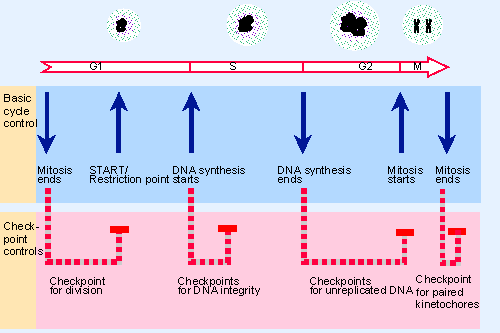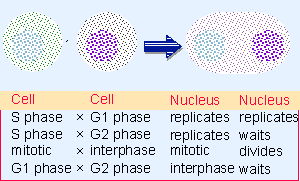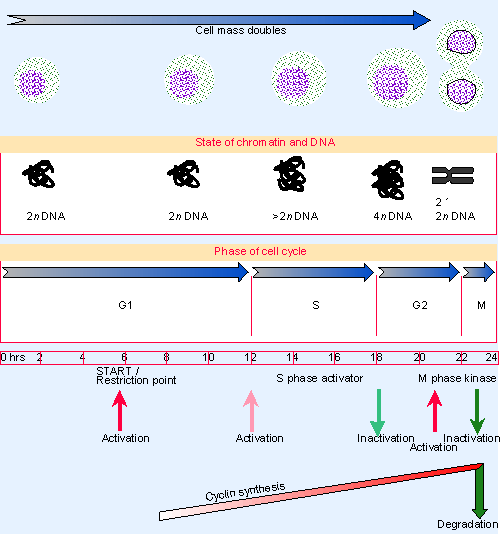3. M phase kinase regulates entry into mitosis
27.2 Cycle progression depends on discrete control points |
| Key terms defined in this section |
| Cyclins are proteins that accumulate continuously throughout the cell cycle and are then destroyed by proteolysis during mitosis. A cyclin is one of the two subunits of the M-phase kinase. Heterokaryon is a cell containing two (or more) nuclei in a common cytoplasm, generated by fusing somatic cells. |
There are two points at which a decision may be taken on whether to proceed through another cell cycle:
- Commitment to chromosome replication occurs in G1 phase. If conditions to pass a "commitment point" are satisfied, there is a lag period and then a cell enters S phase. The commitment point has been defined most clearly in yeast cells, where it is called START. The comparable feature in animal cells is called the restriction point.
- Commitment to mitotic division occurs at the end of G2. If the cell does not divide at this point, it remains in the condition of having twice the normal complement of chromosomes.
How do cells use these two control points?
For animal cells growing in culture, G1 control is the major point of decision, and G2/M control is subsidiary. Cells spend the longest part of their cycle in G1, and it is the length of G1 that is adjusted in response to growth conditions. When a cell proceeds past G1, barring accidents it will complete S phase, proceed through G2, and divide. Cultured cells do not halt in G2. Control at G1 is probably typical of most diploid cells, in culture or in vivo.
 |
Figure 27.1 Overview: interphase is divided into the G1, S, and G2 periods. One cell cycle is separated from the next by mitosis (M). Cells may withdraw from the cycle into G0 or reenter from it. |
Some cell phenotypes do not divide at all. These cells are often considered to have withdrawn from the cell cycle into another state, resembling G1 but distinct from it because they are unable to proceed into S phase. This noncycling state is called G0. Certain types of cells can be stimulated to leave G0 and reenter a cell cycle. Withdrawal from, or reentry into, the cell cycle can occur before the restriction point in G1 (see Figure 27.1).
Some cell types do halt in G2. In the diploid world, these are usually cells likely to be called upon to divide again; for example, nuclei at some stages of insect embryogenesis divide and rest in the tetraploid state. In the haploid world, it is more common for cells to rest in G2; this affords some protection against damage to DNA, since there are two copies of the genome instead of the single copy present in G1. Some yeasts can use either G1 or G2 as the primary control point, depending on the nutritional conditions. Some (haploid) mosses usually use G2 as the control point.
 |
Figure 27.3 Checkpoints control the ability of the cell to progress through the cycle by determining whether earlier stages have been completed successfully. A horizontal red bar indicates the stage at which a checkpoint blocks the cycle. |
The upper part of Figure 27.3 (in blue) identifies the critical points in the cell cycle:
- For a cell with a cycle determined through G1 control, START marks the point at which the cell takes the basic decision: do I divide? Various parameters influence the ability of a cell to take this decision, including the response to external stimuli (such as supply of nutrients), and an assessment of whether cell mass is sufficient to support a division cycle. (Generally a cell is permitted to divide at a mass that is not absolute but is determined by a control that itself responds to growth rate.)
- The beginning of S phase is marked by the point at which the replication apparatus begins to synthesize DNA.
- The start of mitosis is identified by the moment at which the cell begins to reorganize for division.
Each of these events represents a discrete moment at which a molecular change occurs in a regulatory molecule. Once a cell has taken the decision to proceed at START, the other events will follow in order as the result of the cell cycle pathway.
However, superimposed on this pathway are checkpoints that assess the readiness of the cell to proceed. The lower part of Figure 27.3 (in red) shows that each checkpoint represents a control loop that makes the initiation of one event in the cell cycle dependent on the successful completion of an earlier event. A checkpoint works by acting directly on the factors that control progression through the cell cycle.
Many of the checkpoints operate at mitosis, to ensure that the cell does not try to divide unless it has completed all of the necessary preceding events. One important checkpoint establishes that all the DNA has been replicated; other checkpoints determine whether there is any damaged DNA and postpone mitosis until it has been repaired. This explains why a common feature in the cycle of probably all somatic eukaryotic cells is that completion of DNA replication is a prerequisite for cell division. There are also checkpoints within mitosis to ensure that one phase does not start until the previous phase has been completed. Checkpoints also operate within S phase to prevent replication from continuing if there are problems with the integrity of the DNA (for example, because of breaks or other damage). There is a checkpoint that confirms that the previous mitosis has been successfully completed before a cell can proceed through START to commit itself to another cycle.
Two types of cycle must be coordinated for a cell to divide:
- A cell must replicate every sequence of DNA once and only once. This is controlled by licensing factor (see 13 DNA replication). Having begun replication, it must complete it; and it must not try to divide until replication has been completed. This control is accomplished by the checkpoint at mitosis.
- The mass of the cell must double, so that there is sufficient material to apportion to the daughter cells. So a cell must not try to start a replication cycle unless its mass will be sufficient to support division. Cell mass influences ability to proceed through START and may also have a checkpoint at mitosis.
Some embryonic cycles bypass some of these controls and respond instead to a timer or oscillator. So the control of the cell cycle can be coupled as required to time, growth rate, mass, and the completion of replication.
 |
Figure 27.4 Cell fusions generate heterokaryons whose nuclei behave in a manner determined by the states of the cells that were fused. |
The existence of different regulators at different stages of the cell cycle was revealed by early experiments that fused together cells in different stages of the cycle. As illustrated in Figure 27.4, cell fusion is performed by mixing the cells in the presence of either a chemical or viral agent that causes their plasma membranes to fuse, generating a hybrid cell (called a heterokaryon) that contains two (or more) nuclei in a common cytoplasm.
When a cell in S phase is fused with a cell in G1, both nuclei in the heterokaryon replicate DNA. This suggests that the cytoplasm of the S phase cell contains an activator of DNA replication. The quantity of the activator may be important, because in fusions involving multiple cells, an increase in the ratio of S phase to G1 phase nuclei increases the rate at which G1 nuclei enter replication. The regulator identified by these fusions is called the S phase activator.
When an S phase cell is fused with a G2 cell, the S phase nucleus continues to replicate, but the G2 nucleus does not replicate. This suggests that DNA that has replicated becomes refractory to the effects of the S phase activator, a feature to ensure that each sequence of DNA replicates only once. However, a compromise in the timing of mitosis is seen in such fusions. The S phase nucleus enters M phase sooner than it would have in its previous cytoplasm, but the G2 cell does not enter mitosis until after the S phase nucleus has completed replication. This could mean that some regulator in the S phase cell Xperhaps the S phase activator itself Xinhibits the start of mitosis.
When a mitotic cell is fused with a cell at any stage of interphase, it causes the interphase nucleus to enter a pseudo-mitosis, characterized by a premature condensation of its chromosomes. This suggests that an M phase inducer is present in dividing cells.
Both the S phase and M phase inducers are present only transiently, because fusions between G1 and G2 cells do not induce replication or mitosis in either nucleus of the heterokaryon.
 |
Figure 27.5 The phases of the cell cycle are controlled by discrete events that happen during G1, at S phase, and at mitosis. |
Figure 27.5 relates the cell cycle to the molecular basis for the regulatory cyclical events that control transitions between phases. Some of these events require the synthesis of new proteins or the degradation of existing proteins; other events occur by reversible activation or inactivation of pre-existing components. A minimum of three molecular activities must exist:
- During G1, an event whose molecular basis is unknown commits the cell to enter the cycle, that is, to pass START. We do not understand the nature of the lag period before S phase actually begins.
- The period of S phase is marked by the presence of the S phase activator. This is a protein kinase. It is related to the kinase that activates mitosis (which was identified first and is better characterized).
- Mitosis depends upon the activation of a pre-existing protein, the M phase kinase, which has two subunits. One is a kinase catalytic subunit that is activated by modification at the start of M phase. The other subunit is a cyclin, so named because it accumulates by continuous synthesis during interphase, but is destroyed during mitosis. Its destruction is responsible for inactivating M phase kinase and releasing the daughter cells to leave mitosis.
A striking feature of cell cycle regulation is that similar regulatory activities are employed in (probably) all eukaryotic systems. Some of these systems have cycles that superficially appear quite different from the normal somatic cycle. So very rapid divisions in which S phase alternates directly with mitosis characterize the development of the Xenopus egg, where entry into mitosis is controlled by M phase kinase, the very same factor that controls somatic mitosis. Yeast cells exist in a unicellular state, and certain species divide by an asymmetrical budding process; but control of entry into S phase and control of mitosis are determined by procedures and proteins related to those employed in the Xenopus egg. Homologous genes play related roles in organisms as distant as yeasts, insects, and mammals.